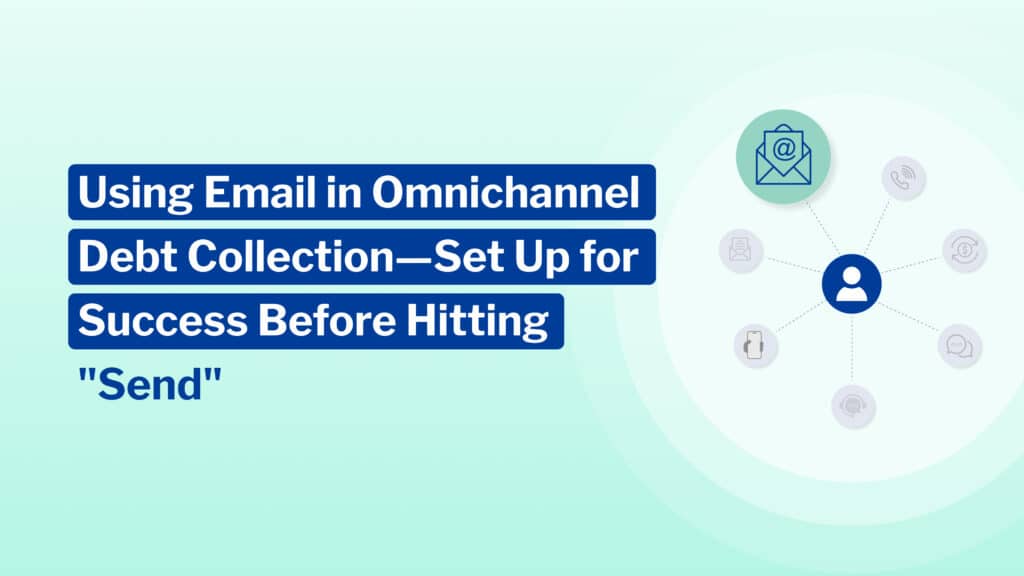Email has come a long way from the mass blast messaging—developing, customizing, and optimizing intelligent email strategies has shown success in both engagement and repayment rates in debt collection. But there’s more that goes into harnessing this channel than just hitting send and hoping for the best.
Here’s how creditors and collectors can strategically leverage email in debt collection communications to enhance engagement, maintain compliance, and drive repayments.
Why is Email Critical in Collection Communications?
In today’s increasingly digital world, most businesses are already using email for consumer communications, from marketing to policy updates, so extending that to engaging delinquent accounts is a natural next step. Email is a familiar tool for both senders and recipients, and businesses benefit from this in terms of engagement and repayments:
- 99% of email users check their email every day, some as much as 20 times a day (vs 94% ignoring unidentified calls)
- Contacting first through a consumer’s preferred channel can lead to a more than 10% increase in payments (and over half of consumers state email as their preferred channel)
- Digital-first consumers contacted digitally make 12% more payments than those contacted via traditional channels
Beyond engagement effectiveness, email is a cost-effective communication tool, especially compared to traditional methods like physical letters or phone calls. Printing, postage, and call center costs quickly add up, whereas email offers a scalable option for communicating with delinquent accounts.
Moreover, email provides a secure and traceable audit trail. Each email sent can be tracked, and responses are timestamped, offering businesses a transparent record of all communications for compliance and reporting purposes.
Core Components for a Successful Email Program
While adding email into the communication channel mix is critical, it is the set up, execution, and continued optimization of that email program that can actually make a difference when it comes to consumer engagement. There are many elements, but three core components of a successful email strategy are:
- Infrastructure: An email program is built on several components—Mail Servers, Mailbox Providers, Internet Service Providers (ISPs), Email service providers (ESPs), and more—and while infrastructure can be complex, the risks a business runs without a sound infrastructure are quite consequential, including having sent emails blocked, deferred or delayed delivery, or winding up lost in the recipient’s spam folder.
- Data: Understanding data collected from consumer interactions helps intelligently influence an email strategy in a debt collection program, especially when focusing on email engagement metrics (such as Opens, Clicks, Unsubscribes, and more)—but skipping over these analytics and just using mass blast techniques can result in consumer complaints, hard bounces, falling into spam traps, and ultimately lower repayment rates.
- Content: Solid infrastructure and reliable data are essential in any email program, but when it comes to debt collection, content can be the tipping point between a consumer committing to repayment or ignoring the outreach altogether (or even reporting your communications as spam or harassment)—from subject lines to your call-to-action (CTAs), sending the right message to consumers is crucial.
If your email efforts are missing any of the core components, it doesn’t matter if your collection strategy qualifies as omnichannel—your operations are going to be missing recovery opportunities.
But let’s take a look at the use cases and success stories that harness the power of email for better consumer experience and bottom line results.
Use Cases and TrueAccord Success Stories
Surveys show 59.5% of consumers prefer email as their first choice for communication, and even the courts have ruled that email is less intrusive than a phone call for debt collection. This case—Branham v. TrueAccord—is a win for consumers, creditors, collectors, and omnichannel as a communication method.
Considering that, when given the opportunity, more than 29% of consumers resolve their accounts outside of typical business hours (before 8am and after 9pm) when it is presumed inconvenient to contact consumers under the federal Fair Debt Collection Practices Act (FDCPA), relying solely on reaching consumers during a call center’s business hours can result in almost a quarter of consumers not engaging or taking the next steps in their repayment process.
Using a sophisticated omnichannel strategy helps TrueAccord reach consumers at times that are right for the consumer and through the right communication channel, which ultimately creates a non-intrusive consumer experience.
